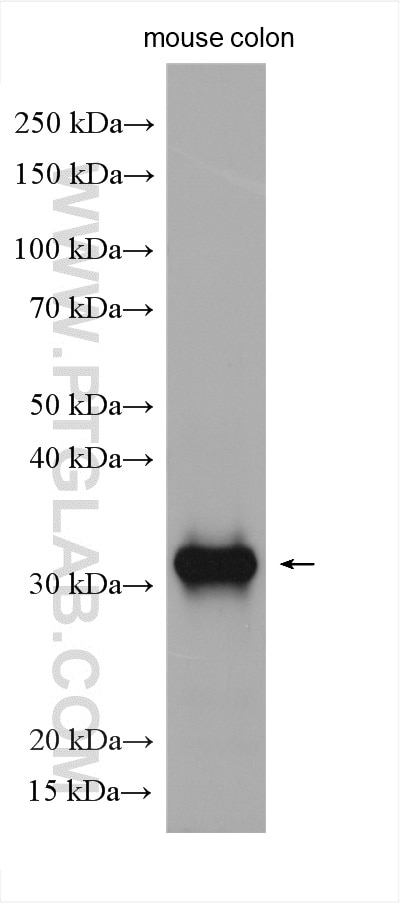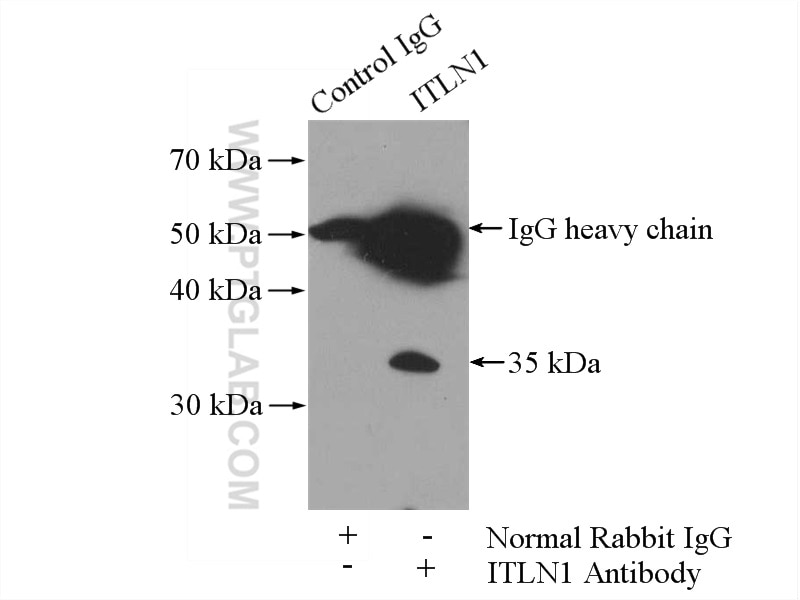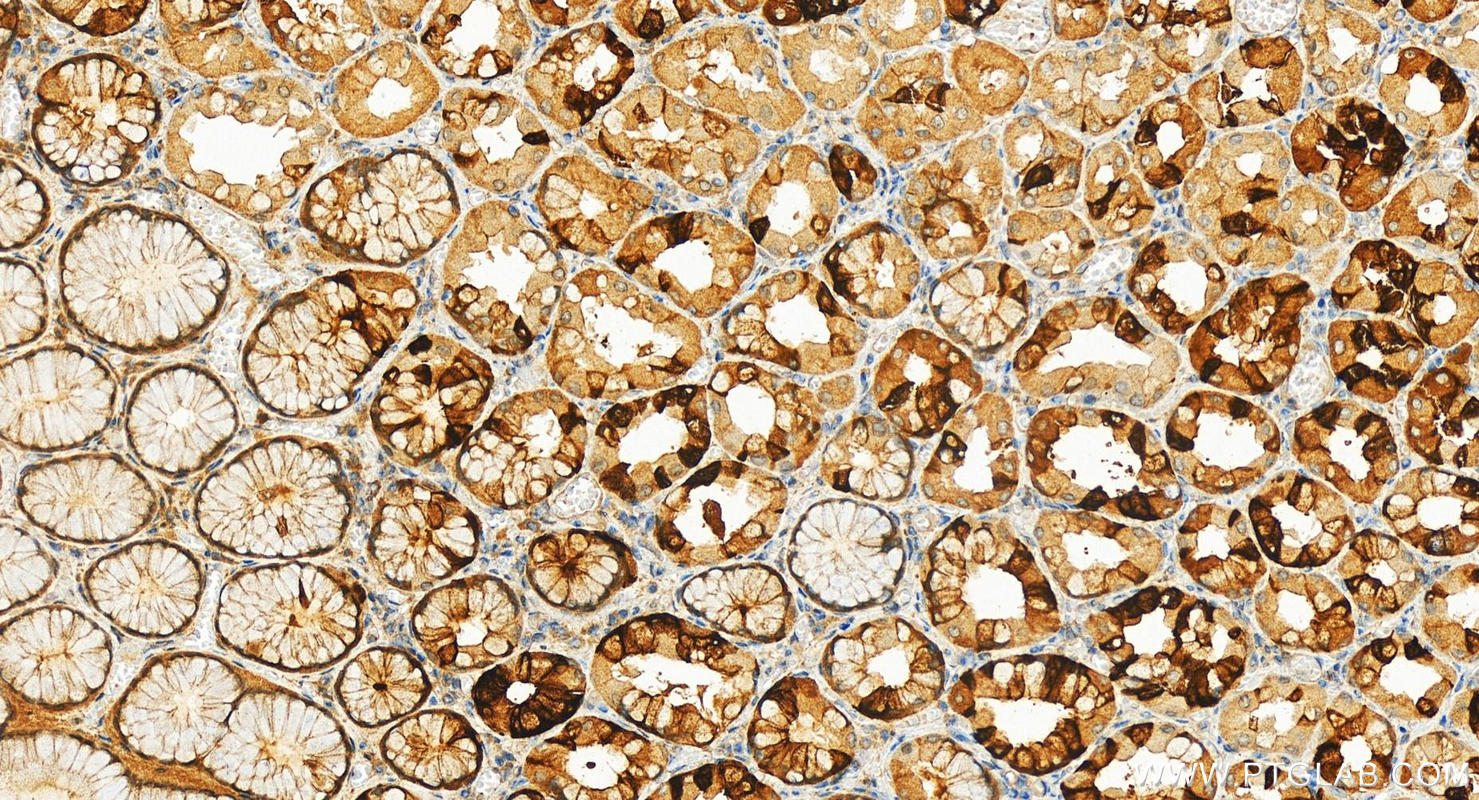Validation Data Gallery
Tested Applications
| Positive WB detected in | mouse colon tissue |
| Positive IP detected in | mouse appendix tissue |
| Positive IHC detected in | human stomach tissue Note: suggested antigen retrieval with TE buffer pH 9.0; (*) Alternatively, antigen retrieval may be performed with citrate buffer pH 6.0 |
Recommended dilution
| Application | Dilution |
|---|---|
| Western Blot (WB) | WB : 1:500-1:3000 |
| Immunoprecipitation (IP) | IP : 0.5-4.0 ug for 1.0-3.0 mg of total protein lysate |
| Immunohistochemistry (IHC) | IHC : 1:200-1:800 |
| It is recommended that this reagent should be titrated in each testing system to obtain optimal results. | |
| Sample-dependent, Check data in validation data gallery. | |
Published Applications
| WB | See 15 publications below |
| IHC | See 5 publications below |
| IF | See 9 publications below |
| IP | See 1 publications below |
| FC | See 1 publications below |
Product Information
11770-1-AP targets ITLN1/2 in WB, IHC, IF, IP, ELISA applications and shows reactivity with human, mouse, rat samples.
| Tested Reactivity | human, mouse, rat |
| Cited Reactivity | human, mouse |
| Host / Isotype | Rabbit / IgG |
| Class | Polyclonal |
| Type | Antibody |
| Immunogen |
CatNo: Ag2424 Product name: Recombinant human ITLN1 protein Source: e coli.-derived, PGEX-4T Tag: GST Domain: 1-313 aa of BC020664 Sequence: MNQLSFLLFLIATTRGWSTDEANTYFKEWTCSSSPSLPRSCKEIKDECPSAFDGLYFLRTENGVIYQTFCDMTSGGGGWTLVASVHENDMRGKCTVGDRWSSQQGSKAVYPEGDGNWANYNTFGSAEAATSDDYKNPGYYDIQAKDLGIWHVPNKSPMQHWRNSSLLRYRTDTGFLQTLGHNLFGIYQKYPVKYGEGKCWTDNGPVIPVVYDFGDAQKTASYYSPYGQREFTAGFVQFRVFNNERAANALCAGMRVTGCNTEHHCIGGGGYFPEASPQQCGDFSGFDWSGYGTHVGYSSSREITEAAVLLFYR 相同性解析による交差性が予測される生物種 |
| Full Name | intelectin 1 (galactofuranose binding) |
| Calculated molecular weight | 313 aa, 35 kDa |
| Observed molecular weight | 35-40 kDa |
| GenBank accession number | BC020664 |
| Gene Symbol | ITLN1 |
| Gene ID (NCBI) | 55600 |
| RRID | AB_2129677 |
| Conjugate | Unconjugated |
| Form | |
| Form | Liquid |
| Purification Method | Antigen affinity purification |
| UNIPROT ID | Q8WWA0 |
| Storage Buffer | PBS with 0.02% sodium azide and 50% glycerol{{ptg:BufferTemp}}7.3 |
| Storage Conditions | Store at -20°C. Stable for one year after shipment. Aliquoting is unnecessary for -20oC storage. |
Background Information
ITLN1, also named as Intelectin 1, has no effect on basal glucose uptake but enhances insulin-stimulated glucose uptake in adipocytes. ITLN1 is a glycoprotein made up of three 40 kDa subunits cross-linked by disulfide bonds making up a 120-kDa homo-trimer of 295 amino acids and N-linked oligosaccharides (PMID: 17621593). It may play a role in the defense system against microorganisms. Human intelectin-1 is expressed in intestinal goblet cells, and is present at about 200 ng/mL in serum. Intelectin-1 was also shown to be expressed in human endothelial cells and adipocytes of human abdominal adipose tissue. (PMID: 22768319,PMID: 28640441)
Protocols
| Product Specific Protocols | |
|---|---|
| IHC protocol for ITLN1/2 antibody 11770-1-AP | Download protocol |
| IP protocol for ITLN1/2 antibody 11770-1-AP | Download protocol |
| WB protocol for ITLN1/2 antibody 11770-1-AP | Download protocol |
| Standard Protocols | |
|---|---|
| Click here to view our Standard Protocols |
Publications
| Species | Application | Title |
|---|---|---|
Nat Commun Tissue mechanics drives regeneration of a mucociliated epidermis on the surface of Xenopus embryonic aggregates. | ||
J Exp Med Single-cell transcriptome analysis reveals differential nutrient absorption functions in human intestine. | ||
Mucosal Immunol Intelectin contributes to allergen-induced IL-25, IL-33, and TSLP expression and type 2 response in asthma and atopic dermatitis. | ||
Front Cell Dev Biol Neuroprotective Effects of Omentin-1 Against Cerebral Hypoxia/Reoxygenation Injury via Activating GAS6/Axl Signaling Pathway in Neuroblastoma Cells. | ||
Fish Shellfish Immunol Molecular properties and ligand specificity of zebrafish intelectin-2. | ||
J Biol Chem Structures of Xenopus embryonic epidermal lectin reveal a conserved mechanism of microbial glycan recognition. |



